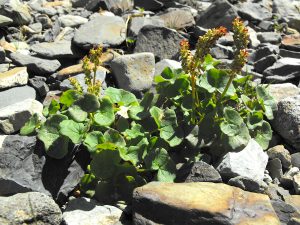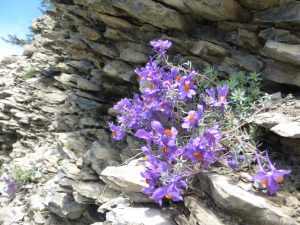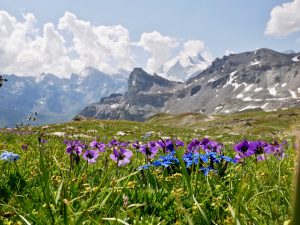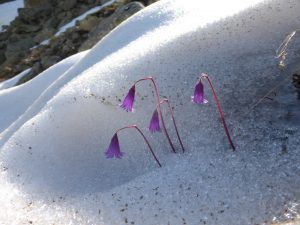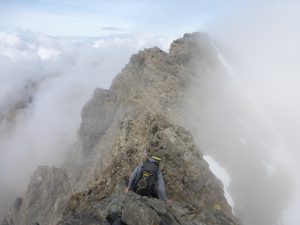Deglaciation in the Alps. We live in a time of great change regarding world climate. The retreat of the world’s ice caps and glaciers continues, exposing new surfaces once covered beneath vast frozen rivers of ice. With the unearthing of these rocky surfaces, comprising of glacially scoured bedrock, boulders and gravels, comes an opportunity for new life to colonise these virgin habitats.
With only a meagre source of minerals and nutrients, pioneer lichens and mosses are able to establish and grow in the exposed and barren landscape with their spores being blown in by the wind. Shortly after specialist plants take root and begin the establishment of the early pioneering community of plants. In such extreme conditions growth is slow, but conditions steadily improve and pockets of soil develop as dead plant materials are broken down, decompose and become available for new plants to utilise the nutrients.
This transformation continues over time with new additions to the plant community. With each addition the conditions in the soil develop and the habitat gradually changes. Each alteration to the environment changes the conditions enough to make it more favourable for different species that take advantage of this new opportunity and the diversity of species rises. Over time this process of development stabilises and the sequence of plant communities comes to rest with characteristic plants that define the ecosystem.
What has been described above is the process known as ‘primary succession’. This is a large-scale pattern and follows the changes in plant communities and the development of soil which occur over time. The final plant community being recognised as the typical vegetation of the area which is largely defined by climate. We notice this as we observe the changes from the milder valleys to the tops of the higher mountains where distinct bands of vegetation occur. Each of these bands of vegetation are characteristic of the altitudinal zones and reflect the natural vegetation of that climate.
Deglaciation in the Alps is linked with succession. Succession is tightly bound to the underlying substrate and the early pioneer species vary according to the nature of this. The substrate and terrain can be wet or dry, exposed or sheltered and the habitat may be solid rock, boulders, gravels or finely ground clay. The plants most suited to the specific conditions of that habitat become established first and begin the process. Interestingly, regardless of the nature of the initial habitat, the final, stable ‘climax’ community will always be the same for that climate and location.
In the Alps there are many examples where primary succession can be seen. The first to colonise, following mosses and lichens, are a community dominated by plants such as Alpine Willowherb, Alpine Toadflax and Yellow Mountain Saxifrage. These plants dominate large areas of the glacial foreland where there are glacial outwash gravels. Other pioneer communities are also observed in wetter areas where Cottongrass, various sedges and ferns can be found. Rocky and bouldery habitats are often colonised by Houseleeks and Adenostyles.
Mountain Sorrel is also an early pioneer species but is a short-lived plant and soon Green Alder and Willow out-compete this and the other small, slow growing pioneer plants. Over time the Green Alder scrub is taken over as the conditions improve and allows the dwarf shrub community to establish, dominated by Alpenrose, Bilberry and Juniper. Eventually the transformation of the ecosystem allows for the formation of the Larch-Arolla Pine forest, climax community.
The importance of soil development is often overlooked but there are many significant changes that occur as the skeletal, mineral soils eventually develop into an organised, deep and organic-rich cover with many distinct layers. Over time nitrogen is added to the soil through the action of nitrogen-fixing plants such as Mountain Avens and Green Alder.
Mycorrhizal fungi, associated with the roots of certain plants such as Spring Heath and grasses, help to accelerate the development of the soil by accessing nutrients and making them available to the plants in exchange for sugars produced by the plants. The organic matter eventually increases and the soil begins to form a continuous ground cover and bacteria and tiny organisms continue to transform leaf litter into soil. Some processes in the soil can take over a thousand years to fully form which neatly illustrates the significance of time in the process of ecological succession.
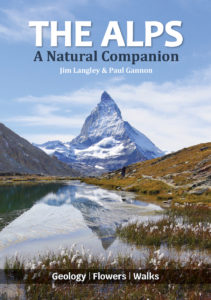 You can expand on Deglaciation in the Alps by reading my book The Alps a natural companion
You can expand on Deglaciation in the Alps by reading my book The Alps a natural companion
Why not join me on a Swiss alpine flower course? Check my courses on EventBrite



